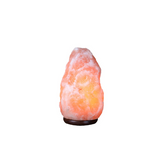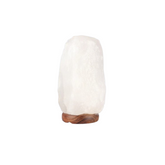Himalayan Salt Lamps and Allergies: Helpful or Harmful?
Himalayan Salt Lamps and Allergies: Helpful or Harmful?
Himalayan salt lamps have become a popular addition to homes and wellness spaces, admired for their warm glow and calming aesthetic. But beyond mood lighting, many wonder: Can these lamps actually help with allergies? With claims ranging from improving air quality to reducing dust and allergens, it’s worth investigating whether these benefits are fact or myth.
This article explores the connection between allergies, dust, and salt lamps, breaking down the science, expert opinions, and practical tips for allergy sufferers.
What Are Himalayan Salt Lamps?
A Himalayan salt lamp is made from pink rock salt crystals, often sourced from mines in Pakistan’s Khewra region. The crystal is hollowed out to hold a bulb, which gives off a soft amber glow when lit.
Advocates claim that heating the salt crystal releases negative ions, which may bind to dust, pollen, and other allergens, removing them from the air. While this sounds appealing, the scientific evidence is mixed.
How Allergies Work
To understand whether salt lamps help, it’s important to understand allergies.
- Allergies occur when the immune system overreacts to harmless substances like pollen, dust mites, or pet dander.
- Symptoms include sneezing, watery eyes, congestion, coughing, and sometimes asthma flare-ups.
- Managing indoor allergens often involves strategies like air filtration, humidity control, and reducing dust buildup.
Salt lamps are often marketed as a natural solution for reducing allergens, but do they live up to the hype?
Do Salt Lamps Improve Air Quality?
The central claim is that salt lamps improve air quality by attracting airborne particles. This is sometimes referred to as hygroscopy, where salt absorbs water molecules from the surrounding environment.
- In theory, dust, mold spores, and allergens stick to these water molecules and settle on the lamp.
- In reality, the amount of airborne particles a salt lamp can capture is minimal compared to air purifiers.
Dust and Salt Lamps: Can They Really Help?
Dust is one of the most common indoor triggers for allergies. Advocates claim that salt lamps attract dust particles. While it’s true that the lamp’s warm surface can collect dust, this effect is no stronger than what any warm object in a room would do.
-
Pros:
- A salt lamp surface may accumulate some dust particles, meaning slightly less floating in the air.
- Regular cleaning of the lamp ensures dust buildup doesn’t spread.
-
Cons:
- The amount captured is minimal compared to HEPA air purifiers.
- Relying solely on a lamp for dust control is not effective.
Are Salt Lamps Helpful or Harmful for Allergies?
Potential Benefits
- Provide calming light that may reduce stress, which can worsen allergy symptoms.
- May collect a small amount of dust and moisture on the lamp’s surface.
- Offer psychological comfort, creating a relaxing environment for those with allergies.
Potential Downsides
- Not a substitute for proven allergy management strategies.
- Can collect dust on their surface if not cleaned regularly.
- If placed in damp areas, salt lamps may “sweat” and leave salty residue, which can attract even more dust.
Child and Pet Safety Considerations
For households with kids or pets, salt lamps pose additional risks:
- Children may accidentally knock them over or touch the hot bulb.
- Pets, especially cats, may lick the salt, which can cause sodium poisoning.
- Always place lamps out of reach and use secure stands as part of general childproofing.
Alternatives for Allergy Relief
If you suffer from allergies, salt lamps should be seen as decorative rather than therapeutic. More effective solutions include:
- HEPA air purifiers to filter dust, pollen, and dander.
- Dehumidifiers to reduce mold and dust mite growth.
- Vacuuming with HEPA filters to control household allergens.
- Regular cleaning of bedding and curtains to minimize dust buildup.
Salt lamps may complement these solutions as part of a cozy, relaxing environment, but they are not replacements.
Common Myths About Salt Lamps and Allergies
There are many myths around salt lamps, especially regarding allergies. For example:
-
“Salt lamps cure allergies.”
→ No scientific proof supports this claim. They may help with ambiance, but not with allergy treatment. -
“Salt lamps produce enough negative ions to clean the air.”
→ Research shows that the negative ion output of a salt lamp is negligible compared to natural sources like waterfalls. -
“Salt lamps replace air purifiers.”
→ They do not have the same effectiveness. For real results, use air purifiers.
For a deeper dive into misconceptions, see our article on Himalayan salt lamp myths.
Final Thoughts
Himalayan salt lamps are beautiful home décor pieces that can provide a calming, ambient glow. While they may collect a small amount of dust and create a relaxing atmosphere, they are not scientifically proven to improve air quality or significantly reduce allergies.
If you’re looking for a natural wellness addition to your space, a salt lamp can certainly enhance your environment. But if your goal is allergy relief, rely on proven methods like HEPA filters and medical guidance. Think of salt lamps as supportive companions rather than solutions.





